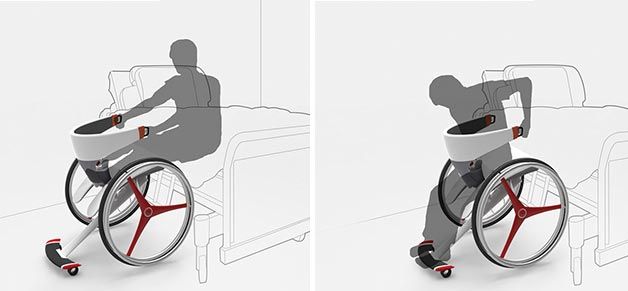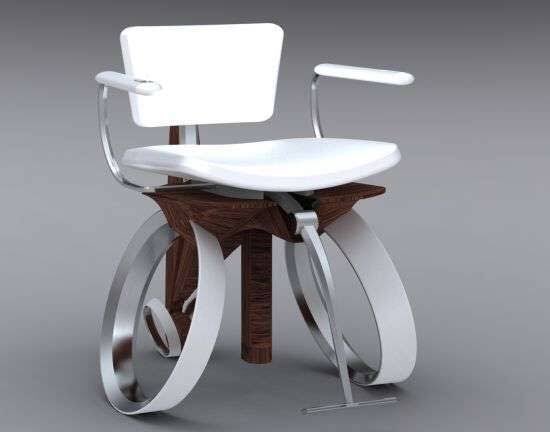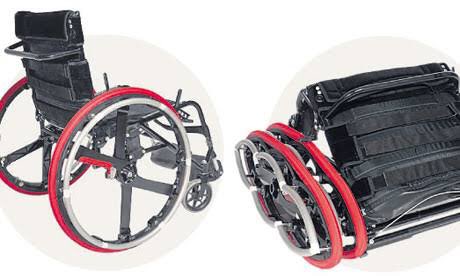Anyway, inclusive design is not a joking matter
- 4 minutes to read
- 10 March 2020
- kitwan
Anyway, inclusive design is not a joking matter
Some time ago I read a thread on Twitter from the wheelchair user “Plant Queer”. He started the thread with “I hate bipeds designing wheelchairs so much…”, followed by numerous photos of wheelchair and mobility aids which he described as nightmares. Here are some examples:

It doesn’t look like the wheelchair is comfortable at all. (Source: Twitter@LeafyQueerCrip)

Does this bulky “Wheelchair Helper” remind you of the Wheelchair Buddy we reported previously? (Source: Twitter@LeafyQueerCrip)

Plant Queer sees this ride-on scooter as “the most uncomfortable looking mobility aid I have ever witnessed”. (Source: Twitter@LeafyQueerCrip)
When I first looked at these photos, I shared similar thoughts as Plant Queer: these futuristic-looking wheelchairs and mobility aids could not look more ridiculous and impractical.
However, there’s a saying “don’t judge a book by its cover”. Hence, I looked for the original source of these tweeted products to better understand their design and functions.
Innovations from the past
My first interesting discovery was that these futuristic-looking wheelchairs and mobility aids were not as new as I've expected. Most of them were actually designed some time ago or have even been sold in the market for some years. One example is the Toyota i-REAL. It was displayed at a motor show in 2007 and has even been featured in Top Gear, the famous British TV motor show!
Most likely mistaken it as an electric wheelchair, Plant Queer commented on i-REAL’s bulkiness, “I hope you did not want to fit through any doors today.” No, driving it indoors may not be the best choice because it is not a wheelchair but an electrically powered vehicle to be driven on the road as fast as 30 kph.
Different perspectives on wheelchairs
As my investigation continued, I found that many of the weird-looking wheelchairs tweeted were designed with considerable thoughts. For example, some are made with light, durable and supportive materials like polyurethane so that wheels or certain parts of the mobility aids are transformable. This helps users to conquer different environmental restrictions such as climbing stairs.
Other product ideas intended for people with disabilities could be hard to believe and understand without a trial. For instance, the wheelchair below won the iF Student Design Award 2015. Its design allows young people paralyzed from the waist down to transfer from their bed into the wheelchair independently through sliding.

I wonder how one can transfer independently from this wheelchair back to the bed. (Source: www.pinterest.com)
Plant Queer couldn’t imagine how to use this wheelchair for going uphill or popping a wheelie without losing balance or falling out backwards. That’s totally in contrast with the award jury’s statement, saying, “A wheelchair for a young demographic, intended to engender a sense of freedom and aid mobility. The idea is fresh and convincing in its proposal.”
Finally, Plant Queer commented on the following product that it “seems to be about looking like you’re a part of the furniture which... honestly we don’t need to feel that any more than we are currently made to”.

This chair is actually a motorised wheelchair meant for home use. (Source: www.coroflot.com)
When inclusive design goes wrong
Now why the dissatisfaction and disappointment even though the designers have considered accessibility and inclusion for their designs? In an interview, Kat Holmes explained what went wrong with inclusive design. Holmes is the Director of User Experience for Google Ads. She has previously worked at Microsoft for seven years, where she led the company’s program for inclusive product innovation. She said,
“It is a challenge when we think of inclusive design as an outcome and object. Inclusive design is a process, not a result.”
Holmes pointed out that it’s crucial to include the excluded communities in the design process, instead of just marketing to them when the design is done. Inclusive designs could become ridiculous when they are created by designers who have no experience with the barriers their products try to tackle. Involving people with disabilities in the design process would make a difference.
Inspiration from the wheelchair community
A successful proof of this is the Morph Wheel – even though Plant Queer found it looking uncomfortable.

A wheelchair made with the world’s first ever foldable wheelchair wheel: Morph Wheels. (Source: Twitter@LeafyQueerCrip)
Designer Duncan Fitzsimons invented the Morph Wheel as a graduate student at the Royal College of Art in London. Originally designing the wheel for folding bicycles, he didn't realize the need of foldable wheelchair wheels until he was approached by many wheelchair users asking about his design.
With the support of wide-ranging experts, including those from the wheelchair community, Fitzsimons invented the Morph Wheel: the world's first foldable wheelchair wheel. The design was one of the finalists at the Saatchi & Saatchi Award for World Changing Ideas in 2008. Today, the wheels continue to be widely used in wheelchairs because of their compactness and convenience for car and air travel.
What are your experiences with inclusive design? What's the weirdest or most useful design you've come across so far?

